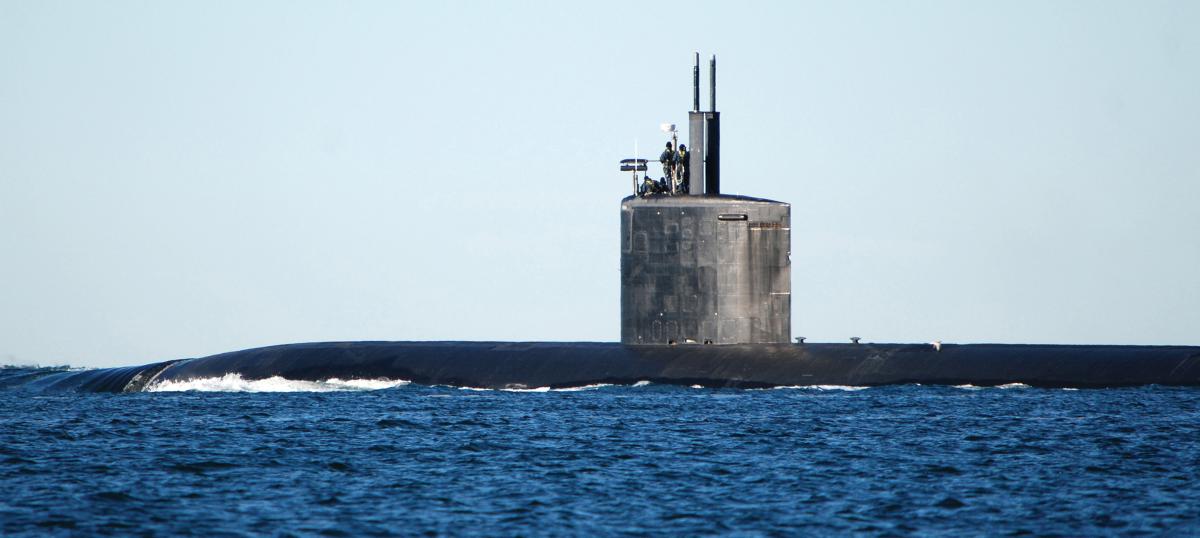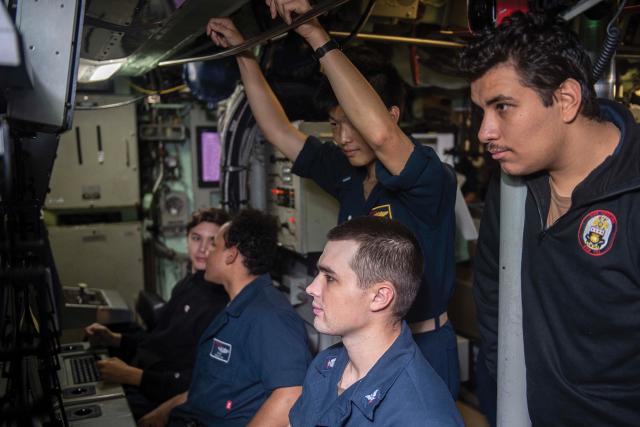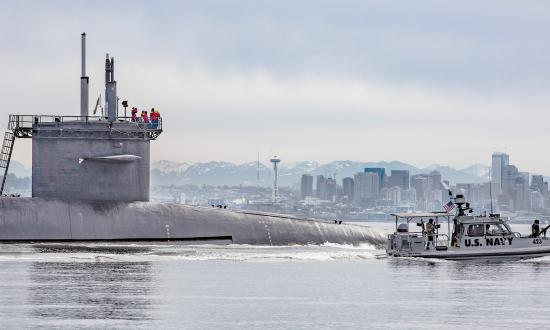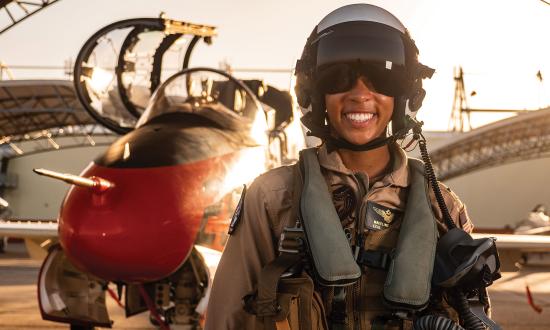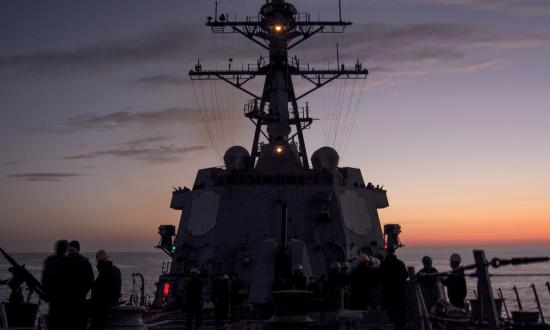Duty officer lay topside. The boat is sinking!” rang in my ears as I snapped awake at 0230 on 15 December 2018, after a relatively normal duty day on board the USS Hartford (SSN-768). My eyelids were heavier than usual; 0530 wake up was the norm. “The boat is sinking” reverberated through the bulkhead. The announcement repeated three times over the primary shipboard announcing system (1MC). Something was seriously wrong. As any first-year Naval Academy midshipman knows, submarines are designed to sink at sea, but we were tied to the pier at Submarine Base New London, Connecticut. The duty chief—the senior enlisted watchstander on board—and I rushed through the hatch to respond to our watchstander on the pier.
The petty officer of the deck was panicking and shouting, “The drafts! The drafts! They dropped by a foot!” I grabbed his logs, looked at the boat, looked at his logs, and then looked at the boat again, and breathed a sigh of relief. We were not in danger of submerging in port. Rather, the petty officer of the deck did not know how to read draft markings, and the drafts in his logs were 12 inches deeper than reality; the boat was safe. The offgoing watchstander was brought up to relieve the watch, and we conducted training with the inexperienced petty officer of the deck on the spot. My duty chief breathed a long and heavy sigh and asked, somewhat sarcastically, “Sir, why do things always happen before the sun is up?” I replied, “Chief, because today’s the day.”
Sarcasm aside and looking back, there was more to that false alarm than a misread draft marker. This scenario highlights three principal responsibilities that each junior officer, in his or her unique role as watch team leader, must maintain and strive to improve on every day: their team’s training, trust, and tenacity.
Train Continuously
Junior officers must take charge and train continuously. On 15 December, I was the senior officer on board the submarine. I woke up to what appeared to be a real emergency, and I was obligated to act as such. The instant my eyes snapped open, it was clear we faced an imminent problem that required leadership and prompt action. I did not have the luxury of time to contemplate why I was placed on duty that day, who could have improperly conducted a procedure that led to in-port flooding, or whether the petty officer of the deck was ready to assume the watch. My watch team and the command entrusted me, as the duty officer, to take charge and lead the team to combat the casualty.
After the imminent concern was dealt with, we faced one further leadership challenge: to critique the events of that morning and determine if the level of knowledge possessed by the Hartford’s petty officer of the deck that day was an outlier or a systemic problem with the qualification process. Clearly, the topside watchstander on that cold December morning was improperly trained to read drafts and should not have been on his first unsupervised watch. At the same time, his prudent use of the 1MC to get the crew’s attention was a strong point in his favor. The lesson of “when in doubt, call the duty officer or duty chief” was one message drilled continuously throughout his qualification process. When panic and uncertainty set in, this petty officer responded with a trained and instinctual reaction.
We also needed to understand the factors underlying why the section leader, duty chief, and I all failed to recognize his inexperience when we approved the watchbill. At turnover the following morning, we conducted a knowledge spot check with a junior watchstander in the relieving section and found that this knowledge gap extended beyond one watchstander. The result was not just short-term training for the petty officer of the deck, but dissemination of the lessons learned for the entire crew as part of a wider, effective, continuous training program.
In contrast to the event on 15 December, I recall a time when I was standing as officer of the deck at sea. It was 0300 on the midwatch, and the Hartford was transiting the Atlantic at 20 knots. The watch had been quiet thus far, and our executive officer (XO) came to control to speak with every watchstander. He spent 15 minutes with each watchstander, asking them a series of questions about their systems. If they were unable to answer his questions, he encouraged them to “get the book out and find out.” He approached me last and said, “Commo, I’ve got your guys reading the books now. They’re going to finish this watch smarter than when they began. Report to me what they learned at turnover.” I was humbled and embarrassed but saw the XO’s point. We had just begun a 184-day deployment, and the United States was expecting us to complete our mission with the highest level of professionalism and competence. On point, every minute, every day.
As the watch team leader, the officer of the deck is responsible for training to ensure the team is ready and operating at peak capacity, so that in the event of a casualty or challenging mission, each team can keep the ship safe. A successful watch team is engaged, is able to recognize and correct problems without prompting, and responds positively to forceful backup. If junior officers do not take ownership of their teams, department heads and the command triad—the commanding officer (CO), XO, and chief of the boat—are required to micromanage at the level of the most junior officer to ensure the safety of ship and mission success. Top-down leadership and micromanagement prohibit senior leaders from appropriately executing their own duties, to the detriment of the fleet’s warfighting capacity. Only by embracing continuous training to ensure watch teams are effective can junior officers avoid micromanagement.
Build Trust
“CRA [chemical-radiological assistant], I need to trust you as the officer of the deck. I’m the command duty officer, and the captain is asleep. If we run into trouble, you, not me, will keep the ship safe and keep the sailors smart.” The XO’s words resounded in my mind that day and were put to the test in July 2017. The Hartford was 500 feet underwater in the middle of the Atlantic Ocean, and I was standing my first officer of the deck on the midwatch, completely unsupervised. The command entrusted me to do more than simply follow night orders and prevent casualties. The CO and XO expected that during every watch I would seek every opportunity to correct deficiencies before they caused a problem, train my watch team, and set up the relieving watch team for success, rather than just “hold down the fort” for hours on end.
Trust also comes from the crew, with the expectation that junior officers understand their divisions’ strengths, weaknesses, needs, and expectations. If that trust dissipates, there are only two possible outcomes: Either the command triad will operate at a lower level and step in to run my division, taking time and resources from the ship’s primary tasking, or my division will work harder not smarter. Overworked divisions spend too much time tackling the nearest challenges, which leads to burnout and dejection.
Be Tenacious
The role of the junior officer ought to be considered as the center of a valley. Information and challenges come at junior officers from both sides of the valley: command and the deckplate. From command’s perspective, junior officers are trusted to understand the commander’s intent and to lead teams to accomplish that intent. From the crew’s perspective, junior officers are expected to completely and accurately understand the mission and put forth an effective plan to empower the crew to succeed. Ultimately, the captain, XO, and department heads may not always have the bandwidth to process the current technical challenges while managing the ship’s operations, nor is it their responsibility. Rather, their experience and expertise can steer the junior officers—who are directly working with the technical experts to fix the equipment—toward a more effective solution.
Conversely, the divisional chief and petty officers may be unaware of the requirements placed on the ship and other maintenance and evolutions scheduled. That is where junior officers’ knowledge of the ship’s planned operations can optimize the divisions’ efforts to find an appropriate solution at an appropriate time.
Junior officers fill a unique role as the bridge between the division and the mission. They can use their knowledge of their divisions’ technical challenges, combined with the operational commitments to the mission, to develop the best solutions. At sea, for instance, we suffered a degradation in the ability to use specific communications because of a localized fault in one of our masts. My division immediately came up with a rote recommendation: Come to periscope depth or surface the ship to raise and lower multiple masts to verify the communication paths. But the weather, waterspace, and other maintenance repairs precluded the division from being able to come to periscope depth and troubleshoot the communications circuits for 18 hours. As a result, I informed command of the issue and used the time submerged to troubleshoot with the reactor controls division and electrical division chiefs and officers.
Tenacity in seeking answers and solving problems is the duty of every junior officer. We spent several hours working the problem, and when all possible solutions were exhausted, I presented our findings to the CO and navigator. “We’ll have to troubleshoot at the surface, sir.” The captain told me afterward, “Commo, I’m glad you spent the time underwater exhausting every option, rather than just throwing in the towel and coming up to ask for help. You saved us a lot of time at periscope depth. I knew you reached the end of your capability when you came to me, references in hand.” Junior officers must balance mission accomplishment and material readiness and should pursue perfection in both arenas with relentless tenacity.
Competent, dedicated, and proactive junior officers are fundamental to the fleet’s success as they complete the mission, improve the lives of sailors, and serve the nation. They must be an effective bridge between commander’s intent and the crew’s abilities. Junior officers are the leaders closest to both senior officers and junior enlisted, and they must be trusted by both groups to carry out their duties, maintain safety, and promote the crew’s personal interests and the interests of the nation. Junior officers must build the tactical acumen to execute the mission and secure the trust of their watch teams to lead effectively. Our imperative is to ensure that the command and the crew know that when we take the watch, the ship is safe with a trained, trusted, and tenacious junior officer having the deck and the conn.



